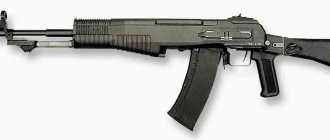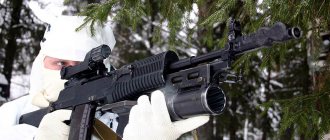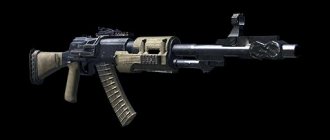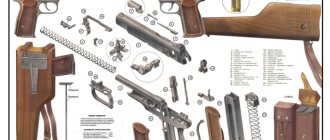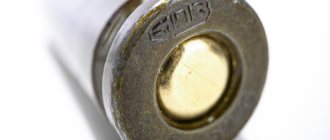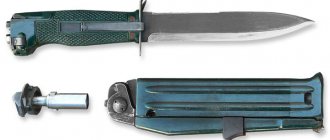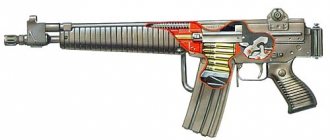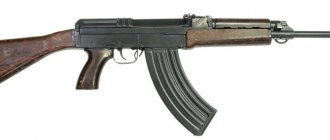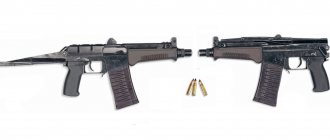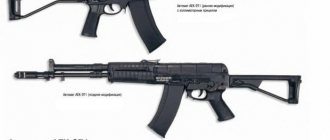"Abakan" by Igor Stechkin. Stechkin assault rifle TKB-0146.
Today, the word “Abakan” among weapon lovers is firmly associated with the Nikonov AN-94 assault rifle, adopted by the Russian army in 1994. The name of the theme of the competition in everyday life somehow “stuck” itself to the design that won the competition. But, in my opinion, it is correct to call each sample submitted to the competition “Abakan”. For example, an automatic machine designed by Igor Yakovlevich Stechkin.
Despite the fact that many designers took part in the development work on the Abakan theme, it was the Stechkin assault rifle that attracted my attention.
I. Ya. Stechkin
Why? After all, this is just one of the losing projects, whose destiny will remain a touch in the national weapons history. But without losers there will be no winners. And from the point of view of constructive novelty and, perhaps, revolutionary courage, only the winner of the competition, the 5.45-mm Nikonov assault rifle (AN-94), is comparable to the Stechkin system.
Let me remind you that, according to the terms of the competition, it was necessary to create an assault rifle that would be 1.5-2 times superior to the AK74 in terms of firing efficiency, while the new system should not be inferior to the AK in terms of reliability, weight-dimensional characteristics, ergonomics, etc.
8 assault rifles initially took part in the competitive tests: TKB-0111 (G. A. Korobov), TKB-0136 (N. M. Afanasyev), AKB (V. M. Kalashnikov), APT (I. A. Postnikov), TKB- 0146 (Stechkin I. Ya.), AEK-971 (Gareev B. A.), AEK-978 (Pikinsky P. A.) and AS (Nikonov G. N.).
Someone tried to solve the problem posed by the competition by relying on the still unrealized reserves of the traditional automation scheme (Kalashnikov, Korobov), someone relied on a system with balanced automation that seemed promising and simply implementable (Gareev, Pikinsky), while Nikonov and Stechkin went untrodden path - they tried to create systems with a shifted recoil impulse. However, they didn’t try, but made such machines, and one of them won the “Abakan” competition. Moreover, only the designs of Nikonov and Stechkin reached the stage of field testing (the Korobov assault rifle was also tested at the test site, but optional).
Serial "bulpups" of foreign production, which are in service with the armies of various countries around the world. From top to bottom: L85A1 (UK), FAMAS (France), AUG (Austria)
Despite the fact that this material is not dedicated to the competition itself, but to the Stechkin assault rifle, I will say a few words about why Nikonov won. This is necessary because since the mid-90s of the last century, no, no, and there are rumors that the Izhevsk design was “pushed through”, that the Nikon assault rifle was not objectively the best... Was! Nikonov's sample truly surpassed the AK74 in efficiency and beat all rivals in terms of reliability. Perhaps today the competing samples have been finalized and, theoretically, can satisfy the conditions of the competition. But, good spoon for dinner, the train has left - 10 years ago they, as they say, “did not correspond.” A contender for victory in the competition had to not only surpass the AK74 in certain parameters, but also beat competitors in a very difficult fair fight. Nikonov won, the rest lost. Stechkin was also a loser, but this did not make his machine gun any less interesting.
The Stechkin assault rifle was the only “bulpup” presented at the competition and the only example with a shifted recoil impulse and a fixed magazine. The fact is that for preliminary tests Nikonov provided an AS assault rifle, in which, when firing at a high rate, the moving parts rolled back along with the magazine. Is it necessary to talk about the inconveniences of using such weapons? It is unlikely that this decision seemed successful to Nikonov himself, but he began competition trials with just such a system. For the first field tests, Gennady Nikolaevich also brought an ASM assault rifle, already with a fixed magazine, but only for familiarization. And Stechkin made such a sample at least a year earlier, implementing in metal the idea of two-stage (two-stage) feeding of a cartridge from the magazine to the chamber. But “earlier” does not always mean “better”. And we know this for sure.
Automatic machine designed by I. Ya. Stechkin TKB-0146, developed as part of development work on the “Abakan” theme. Left view
The Stechkin assault rifle is a very beautiful weapon. This may be a subjective statement, but it is true. Beauty is a direct consequence of the elegant layout solutions used by Igor Yakovlevich. His machine gun is a rare example of a bullpup, where the sights do not stick out like a ridiculous poker above the weapon.
What is the cost of forced removal of a spent cartridge case? Stechkin was able to solve the problem common to all “bulpups” of the convenience of firing a weapon, both with the right and left hands. And no replaceable or adjustable elements! The spent cartridge case is ejected from the receiver not through the side window above the magazine, but through a special hole located in front of the fire control handle.
TKB-0146. Right view. Caliber 5.45x39, machine gun length 970 mm, barrel length 420 mm, weight without magazine and accessories 3.8 kg, muzzle velocity 920 m/s. The machine gun is stored in the domestic weapons fund of the Military Historical Museum of Artillery, Engineering Troops and Signal Corps
The bolt cocking handle remains stationary when firing, in the extreme forward position.
A kind of “tray” under the barrel is intended for attaching a bayonet-knife or an under-barrel grenade launcher.
The safety switch is located on the left side of the receiver and has three settings: “P”—the safety is on, “O-A”—single/automatic fire, and “2”—fire in bursts of 2 shots.
Left: to prevent self-loosening, the folding head of the screw securing the stock is recessed into a shaped recess in the buttplate. Right: view of the front of the machine gun (cleaning rod removed). Moving parts in rearmost position
When the translator is in the “O-A” position, pressing the trigger “to the step” ensures the firing of a single shot. With further squeezing of the trigger, the trigger switches to automatic fire mode at a normal rate (600 rounds/min.).
When installing translator “2”, the machine gun fires in bursts of 2 shots at a high rate (about 2000 rounds/min.). Actually, this is a firing mode with a shifted recoil impulse.
Left: The safety switch is located on the left side of the receiver housing. It is fixed in three positions: “P” - the safety is on, “O-A” - single fire + automatic (600 rounds/min.) and “2” automatic (2000 rounds/min.) in bursts of 2 shots. The diopter sight is mounted on a compact base on the receiver cover and has 6 settings: “P”, “1”, “2”, “3”, “4” and “5”. The possibility of installing optical and night sights on the machine gun is not provided. Right: the front swivel is located on the left side of the front sight base. The tray under the barrel is designed for installation of an under-barrel grenade launcher (GP-25) and a bayonet of an original design
The main parts of the trigger mechanism of the machine gun are mounted inside the receiver cover, so the trigger is located “upside down” - its axis is above the firing pin. When the hammer is cocked, the end of the mainspring guide rod protrudes from the rear of the receiver.
The system's automation operates using the energy of powder gases removed from the barrel through a side hole with a short stroke of the piston interacting with the bolt frame. The barrel bore is locked by two bolt lugs when turning it.
It was planned to use a four-row magazine with increased capacity (60 rounds) with the machine gun. Due to the insufficient development of the magazine, the machine entered testing with a magazine for 30 rounds. To ensure the connection of a 30-cartridge magazine, two inserts are riveted into the receiving window of the receiver. The cavity in the fire control handle is intended for stowing a pencil case with an accessory
The high rate of fire in the Stechkin system is ensured by the reduced stroke of the moving parts and the presence of a buffer spring, which increases the roll-up speed of the moving parts. In high-tempo mode, when moving parts (barrel, receiver, bolt frame with bolt) roll back, two shots are fired. At a time when the entire mobile group is moving back after the first shot, the bolt carrier with the bolt overtakes (in the “backward” direction) the receiver and sends the second cartridge into the chamber, picking it up from the intermediate feeder. In this case, the primer of the first cartridge is broken by the trigger (through the firing pin, of course), but with the second shot the trigger can no longer reach the firing pin. Therefore, the primer of the second cartridge is broken by the bolt frame acting on a special protrusion of the firing pin.
If shooting is carried out at a normal pace, then the breaking of the primer with each shot is carried out by the trigger when the moving parts come to the forward position.
The supply of cartridges from the magazine to the chamber in a Stechkin assault rifle is carried out in two steps. First, the cartridge from the magazine hits the intermediate feeder and from there it is sent into the chamber. 1 — cartridge in the magazine; 2 — cartridge on the intermediate feeder; 3 - cartridge in the chamber
The supply of cartridges from the magazine to the chamber has its own characteristics. If you move the reloading handle to the rearmost position and release it, the first cartridge from the magazine will be fed by the bolt frame rammer onto the intermediate feeder tray. In order for the cartridge to enter the chamber, the manipulation with the handle must be repeated - the bolt will pick up and place a cartridge from the tray into the chamber, and the bolt frame will “put” the next cartridge from the magazine onto the tray. The weapon is also unloaded in two steps - first, the cartridge is ejected from the chamber, and then the second cartridge, which was waiting its turn on the tray and was sent into the chamber when the first cartridge was ejected (of course, all this is done with the magazine disconnected). The cartridge removed from the chamber (or the spent cartridge case when firing), when the bolt frame moves backward, is moved into the cartridge case by a special lever reflector, and then, when the bolt frame rolls up, it is pushed out of the receiver casing by the bolt protrusion.
One must think that from the brief description of the machine, its design seems too sophisticated. It seemed so to me when I first picked up a Stechkin assault rifle in the domestic weapons collection of the Military Historical Museum of Artillery, Engineering Troops and Signal Corps. In fact, it turned out to be more difficult not to understand the design, but to literally disassemble the machine. The sample is stored in the fund as faulty and completely dry inside (without lubrication). And how can you lubricate the parts of a machine gun if the system is tightly jammed and it turns out to be possible to separate only the magazine, butt and receiver cover without any problems? It took me and the custodian of the foundation, Peter Gariglyad, several hours to get all the moving parts of the weapon to interact properly. Further - it’s easier, but not simpler. Even by today’s standards, it’s hard to call the parts of the moving group of the machine gun easy to manufacture. The pretentiousness of the profiles, the precision of the mating surfaces, and the presence of small elements became the price for making the unique system work.
The spent cartridge case (or cartridge when unloaded) is removed from the receiver casing through a window above the fire control handle, covered with a spring-loaded lid.
I am far from idealizing Stechkin’s design, especially since the tests revealed a large number of shortcomings and not all of them can be classified as easily removable. Yes, the Stechkin assault rifle did not pass competitive tests, but it turned out to be a worthy rival to the winner—the Nikonov assault rifle. At one stage of testing, TKB-0146 was even recognized as the most promising model of all competitive products in terms of improving accuracy. And, who knows, maybe it was Igor Yakovlevich’s bold decisions that made Gennady Nikonov finally believe in the viability of the gun monitor scheme with a fixed magazine. In many ways, it was this feature of the ASM assault rifle (as opposed to the AS) that allowed Nikonov to fulfill the conditions of the competition.
Parts of the moving group and receiver cover. The trigger mechanism is mounted in the receiver cover
Unfortunately, I actually did not know Igor Yakovlevich. I met a couple of times, was introduced, but was late with questions about the machine... We didn’t have time to do a lot with Gennady Nikonov either - he had just started collaborating with our magazine, there were plans, the implementation of which was prevented by Gennady Nikolaevich’s natural modesty and his sudden death.
Details of the TKB-0146 machine gun. 1 — receiver cover with trigger mechanism; 2 - return mechanism; 3 — bolt frame; 4 - shutter; 5 - drummer; 6 — gas piston; 7 — gas chamber plug; 8- barrel with receiver; 9 — receiver return spring; 10 — receiver casing with fire control handle; 11 — muzzle brake-compensator; 12 - coupling; 13 — clutch spring; 14 — butt mounting rod; 15 — ramrod; 16 — cocking handle; 17 — fore-end pads; 18 — forend lining clamp; 19 - store
But theoretically, I had the opportunity to meet both of them 10 years earlier, in the summer of 1987. Then I took the entrance exams to the Leningrad Mechanical Institute (not yet knowing how far the chosen specialty was from small arms), and Nikonov and Stechkin, having arrived from Izhevsk and Tula, walked in the evenings from the checkpoint of the Rzhevka training ground to the train platform on the outskirts of Leningrad - Field tests of their assault rifles were in full swing. And the tests were led by Major Yuri Ponomarev, now a colonel and scientific editor of the KALASHNIKOV magazine.
Our roads could easily cross somewhere in the city center on a weekend. It is easy to assume that one day we passed very close to each other... It is also easy and pointless to say that Stechkin could have won the competition. He didn’t win, but he played with dignity, leaving, like dozens of domestic gunsmith designers, a mark on history. How noticeable this mark will be depends only on those who deal with weapons today and love them. From you and me, dear readers.
Three unusual machines of the twentieth century
In the world of automatic small arms, sometimes you come across quite unusual models.
The features of their design and appearance set them apart from other machines. But the most unusual, as a rule, are the machines that never made it into mass production. Perhaps the most productive years for the creation of “strange” machines were the 1960s and 1970s. At the height of the Cold War, the military departments of many countries were interested in finding the most effective solutions to create fast-firing and powerful automatic weapons. In turn, the designers, wanting to satisfy the needs of the military, proposed more and more extravagant ideas.
For example, back in 1963-1965, Soviet designer Nikolai Mikhailovich Afanasyev developed a very interesting prototype of the TKB-011 assault rifle (Tula Design Bureau). It was one of the first machine guns with a bullpup layout, in which the trigger is moved forward and located in front of the magazine and firing mechanism. This arrangement made it possible to reduce the length of the weapon without the need to reduce the length of the barrel and the associated decrease in accuracy and accuracy of fire.
In one of the articles published in the American magazine The National Interest, the TKB-011 assault rifle and another Soviet assault rifle, TKB-022, designed by German Korobov, were compared to “alien weapons,” focusing on their unusual appearance. But the TKB-1046 assault rifle is even more interesting.
TKB-1046
The development of the TKB-0146 assault rifle was carried out under the leadership of the famous designer Igor Yakovlevich Stechkin, which is why it received the unofficial name “Stechkin assault rifle.” The weapon was developed to participate in the Abakan competition, announced by the USSR Ministry of Defense in 1978 to determine the most effective machine gun, which has better characteristics compared to machine guns already in service with the Soviet Army.
Like TKB-011 and TKB-022, TKB-0146 was configured according to the bullpup principle, and the automatic operation of this weapon was based on the removal of powder gases from the barrel through a side hole.
The machine gun implemented the principle of a displaced recoil impulse with a stationary magazine using a two-stage supply of a cartridge from the magazine to the chamber. But the most impressive feature of the TKB-0146 assault rifle was, of course, the ability to fire almost 2 thousand shots in automatic mode. By the way, it was the excessive consumption of cartridges that became one of the reasons why the TKB-0146 was nevertheless rejected and did not go into mass production.
Automatic H&R SPIW
American designer David Dardick is better known to us for his “pistol-revolvers”. However, his company, which produced hybrid pistols and revolvers, did not last long. But in the early 1960s. David Dardik decided to participate in a program to develop automatic weapons with an increased rate of fire, bullet speed and accuracy of fire.
As a result, in 1964, David Dardick introduced the H&R SPIW assault rifle. It was equipped with a three-shot revolver-fed underbarrel grenade launcher. Naturally, Dardick reproduced in the new weapon the drum feed system used in Dardick pistols. The machine gun had three barrels and was loaded with cartridges with a plastic sleeve. The bullets flew out at speeds of up to 1400 m/s. Automatic fire had a rate of 500 rounds per minute.
The H&R SPIW assault rifle fired in volleys from three barrels, which made it possible to increase the accuracy of fire without the need to complicate the design of the weapon. But such a solution looked beautiful only on paper: in reality, the accuracy of fire was lower than that of competing machine guns, the machine itself was twice as heavy as prescribed by the terms of the competition, and its safety for the shooter left many questions. As a result, the machine was not allowed to participate in the main part of the tests, and the contract with Dardik was terminated.
Automatic rifle G11
Naturally, Germany also conducted its own developments in the field of automatic weapons during the Cold War.
Heckler & Koch, together with Dynamit Nobel AG, during the 1970s and early 1990s. worked on the G11 automatic rifle project. As a result, in the early 1980s. an automatic rifle appeared in a plastic case resembling a trapezoid, where the only protruding parts were the fire control handle and the optical sight. The G11 assault rifle operated in a bullpup manner, fired a caseless cartridge, and the magazine was placed above the barrel. The G11 used a carriage design, that is, the barrel, magazine and breech were mounted on the same base.
However, the military was not satisfied with the test results of the new automatic rifle. It showed its unreliability, the incredible complexity of the mechanism, and the cartridges turned out to be extremely fragile. As a result, the Bundeswehr never accepted the new rifle into service, and its project was gradually curtailed and forgotten.
| TKB-0146 |
In 1974, with the adoption of the 5.45-mm AK-74 assault rifle into service by the Soviet Army, a certain stage in the development of small arms was completed. The main achievement was the development of a sufficiently powerful, lightweight, low-pulse cartridge. The AK-74 assault rifle itself, despite many positive qualities, did not get rid of the main drawback of its predecessor AK - low accuracy of burst fire - noted back in 1947.
The tactics of modern combat dictated their conditions. The highly maneuverable actions of mobile combat units required fairly effective automatic fire, mainly from unstable positions: standing from a short stop, from a knee, lying down from the hand. Therefore, by Decision of the Commission of the Presidium of the Council of Ministers of the USSR on military-industrial issues No. 280 dated August 27, 1981, the Abakan R&D was launched with the main purpose - the development of a new machine gun that is 1.5 - 2.0 times superior in combat effectiveness to the standard one ( at the same time, the new system should not be inferior to the AK in terms of reliability, weight and size characteristics, ergonomics, etc.). The work was undertaken by designers from TsKIB SOO, Kovrov Mechanical and Izhevsk Machine-Building Plants under the general scientific and methodological guidance of the Central Scientific Research Institute of Precision Engineering (TsNIITochmash).
It took three years to develop the concept of the new weapon, technical design, production of prototypes and factory testing.
By August 1984, eight prototypes of experimental machine guns from eight designers had been manufactured. The following machines were subjected to preliminary tests at the technical design stage in August-November 1984:
- TKB-0111 (TsKIB SOO, designer G. A. Korobov), TKB-0136-3M (TsKIB SOO, designer N. M. Afanasyev), TKB-0146 (TsKIB SOO, designer I. Ya. Stechkin), AEK-971 (SKB KMZ, designer Garev B. A.), AEK-978 (SKB KMZ, designer Pikinsky P. A.), AL-9 (PO Izhmash, designer Kalashnikov V. M.), AS (PO Izhmash , designer Nikonov G. N.), APT (PO "IzhNITI", designer Postnikov I. A.).
Main components and parts of TKB-0146: 1-receiver cover with trigger;
2-return mechanism; 3-bolt frame; 4-shutter; 5-drummer; 6-gas piston; 7-gas chamber plug; 8-barrel with receiver; 9-return spring; 10-receiver casing; 11-muzzle brake-compensator; 12-way coupling; 13-clutch spring; 14-stock mounting rod; 15-ramrod; 16-bolt cocking handle; 17-fore-end pads; 18-forend lining retainer; 19-store; 20-butt. The commission, appointed by the decision of the Ministry of Defense Industry and the GRAU, reviewed the test results and confirmed the fundamental possibility of creating a promising machine gun. At the same time, the APT assault rifle was removed from testing due to unreliable operation of the automation, and it was decided to carry out further development of the TKB-0111 assault rifle (the least promising) optionally without concluding a contract. Refinement of the machines in terms of increasing the reliability of the automation, the service life of parts and the accuracy of fire took a year and a half.
In May - June 1986, a preliminary stage of testing was carried out at the TsNIITochmash base. The previously tested assault rifles were joined by AKB-1 (instead of AL-9, designer V. M. Kalashnikov) and AO-63 (TsNIITochmash).
The test program included an extremely large volume: firing in dusty conditions, sprinkling, in extreme temperatures, at high angles of elevation and declination, determining the accuracy and efficiency of firing from all positions. Not a single sample met the established requirements for reliability of automatic operation, service life of parts, shot volume and weight. Only AS and AO-63 met the requirements for accuracy. Only three months were allotted to eliminate the shortcomings.
Repeated preliminary tests began at the end of October 1986. During the tests, two fundamentally new samples of ASM designed by G. A. Nikonov (displacement of the recoil impulse with a stationary magazine) and a battery instead of AKB-1 designed by V. M. Kalashnikov (balanced automatic) were presented.
Refinement of the remaining samples was reduced to clarifying the designs of the trigger and cartridge-feeding mechanisms, and modifying the muzzle devices. Already by the middle of the tests, it became clear that further work with TKB-0111, AEK-971 and battery was unpromising.
The AC, ACM and TKB-0146 assault rifles showed excellent accuracy of fire. Testers and commission members unanimously noted the greater comfort of shooting from these samples: almost imperceptible recoil (when shooting at a high rate from a standing position, machine guns can be held suspended without resting the butt on the shoulder) and the “soft” sound of the shot. A short burst of two shots at a high rate is perceived by ear as a single shot, although the eyes of an observer standing at a distance from the shooter can record the flight path of two reflected cartridges.
| Caliber, mm | 5.45x39 |
| Length, mm | 794 |
| Barrel length, mm | 418 |
| Weight without magazine, kg | 3.5 |
| Store, count. cartridges | 30 |
| Rate of fire, rds/min | 600 / 2000 |
| Sighting range, m | 800 |
Thus, only three samples were suitable for evaluation field tests - AC, ACM and TKB-0146. Although the Nikonov and Stechkin assault rifles showed good results in terms of accuracy of fire, due to the complexity of the design and the increased contamination of automatic parts, they had low reliability.
Subsequently, based on the results of military tests, the Nikonov ASM assault rifle was recommended for adoption, the final version of which was released in 1994 under the official name “5.45-mm Nikonov assault rifle mod. 1994 (AN-94)” was adopted by Russia. The Stechkin TKB-0146 assault rifle remained in the category of experimental weapons.
The TKB-0146 assault rifle (Tula Design Bureau, sample No. 0146), developed by I. Ya. Stechkin at the Tula TsKIB SOO and participated in the Abakan competition, was the only weapon designed according to an unconventional design.
TKB-0146 was configured according to the “bullpup” design, the disadvantage of which was the location of the cartridge ejection window close to the shooter’s eyes. However, Stechkin was able to solve a problem common to all bullpups by forcibly removing spent cartridges, which were ejected from the receiver not through a side window above the magazine, but brought forward through a special hole located above the fire control handle. Another feature of the machine was a shifted recoil impulse with a fixed magazine (two-stage supply of a cartridge from the magazine to the chamber).
View of the side window for ejecting cartridges.
The weapon's automation operates using the energy of powder gases removed from the barrel bore through a side hole during a short stroke of the piston interacting with the bolt frame. The barrel bore is locked by turning the bolt onto two lugs.
The barrel and bolt are combined into a special unit, which allows for single, automatic firing and firing in bursts of two rounds.
The cocking handle is located on the right side of the receiver; the slot is closed with a spring-loaded lid to prevent sand and dirt from getting inside the weapon. The handle itself, in the stowed position, folds forward along the receiver. When firing, the shutter cocking handle remains motionless in the extreme forward position.
The main parts of the trigger mechanism of the machine gun are mounted inside the receiver cover, so the trigger is located “upside down” - its axis is above the firing pin. When the hammer is cocked, the end of the mainspring guide rod protrudes from the rear of the receiver. The USM provides three fire modes: single, automatic and fixed 2 shots.
Parts of the moving group and receiver cover.
The trigger is mounted in the receiver cover. The firing mode safety switch is located on the left side of the receiver above the pistol grip and has three settings: “P”—the safety is on, “0-A”—single/automatic fire, and “2”—fire in bursts of 2 shots. When the translator is in the “0-A” position, pressing the trigger “to the step” ensures the firing of a single shot. With further squeezing of the trigger, the trigger switches to automatic fire mode at a normal rate (600 rounds/min.). When the translator is in position “2”, the firing mode with a shifted recoil impulse is activated, and the machine gun fires in bursts of 2 shots.
When firing in bursts of two rounds, the machine's rate of fire is about 2000 rounds/min, and the shooter feels the recoil as from a single shot, which greatly increases accuracy. A high rate of fire is ensured due to the reduced stroke of the moving parts and the presence of a buffer spring, which increases the roll-up speed of the moving parts. In high-tempo mode, when the moving parts (barrel, receiver, bolt frame and bolt) roll back, two shots are fired. At the time when the barrel with the receiver moves back after the first shot, the bolt frame with the bolt manages to roll back to the rearmost position and send the second cartridge into the chamber, picking it up from the intermediate feeder. In this case, the primer of the first cartridge is broken by the trigger (through the firing pin), but during the second shot the trigger cannot reach the firing pin. And in view of this, the capsule of the second cartridge is broken by the bolt frame acting on a special protrusion of the firing pin.
If shooting is carried out at a normal pace, then the breaking of the primer with each shot is carried out by the trigger when the moving parts come to the forward position.
| Top view of the TKB-0146 receiver: 1 cartridges in the magazine; 2-cartridge on a tray; 3-flange cartridge in the chamber. |
The supply of cartridges from the magazine to the chamber has its own characteristics. If you move the reloading handle to the rearmost position and release it, the first cartridge from the magazine will be fed by the bolt frame rammer onto the intermediate feeder tray. In order for the cartridge to enter the chamber, the manipulation of the handle must be repeated - the bolt will pick up and send a cartridge from the tray into the chamber, and the bolt frame will “put” the next cartridge from the magazine onto the tray. The weapon is also unloaded in two steps - first, the cartridge is ejected from the chamber, and then the second cartridge, which was waiting for its turn on the tray and was sent into the chamber when the first cartridge was ejected (of course, all this is done with the magazine disconnected). The cartridge removed from the chamber (or the spent cartridge case when firing), when the bolt frame moves backward, is moved into the cartridge case by a special lever reflector, and then, when the bolt frame rolls up, it is pushed out of the receiver casing by the bolt protrusion.
The weapon is fed with ammunition from standard magazines from an AK-74 assault rifle with a capacity of 30 rounds. The magazine latch is located behind the magazine receiver window, on the butt.
The sight is diopter, reversible, has fixed sighting ranges of 100 m, 300 m, 500 m and constant (800 meters). The front sight is cylindrical, with safety wings.
View of the rear sight and safety
The buttstock, pistol grip and forend are made of polymer material.
In the butt there is a pencil case with a tool for servicing the weapon. Also, a round cover is screwed into the butt plate, allowing access to the return spring rod.
On the front sight post and at the bottom of the butt there are swivels for attaching a belt.
The ramrod is attached above the fore-end and receiver.
A kind of “tray” under the barrel is intended for attaching a bayonet or an under-barrel grenade launcher.
According to experts, the parts of the moving group of the TKB-0146 assault rifle are quite difficult to manufacture. The pretentiousness of the profiles, the precision of the mating surfaces, and the presence of small elements became the price for making the unique system work. Tests revealed a large number of shortcomings and not all of them can be classified as easily removable.
Although the Stechkin assault rifle did not withstand the tests, it turned out to be a worthy rival to the winner - the Nikonov assault rifle. At one stage of testing, TKB-0146 was even recognized as the most promising model of all competitive products in terms of improving accuracy.
| TKB-0146 |
